

European Parliament Resolution of 20 April 2023 on the crackdown on the right to education and education rights activists in Afghanistan, including the case of Matiullah Wesa (2023/2648(RSP)) – EN
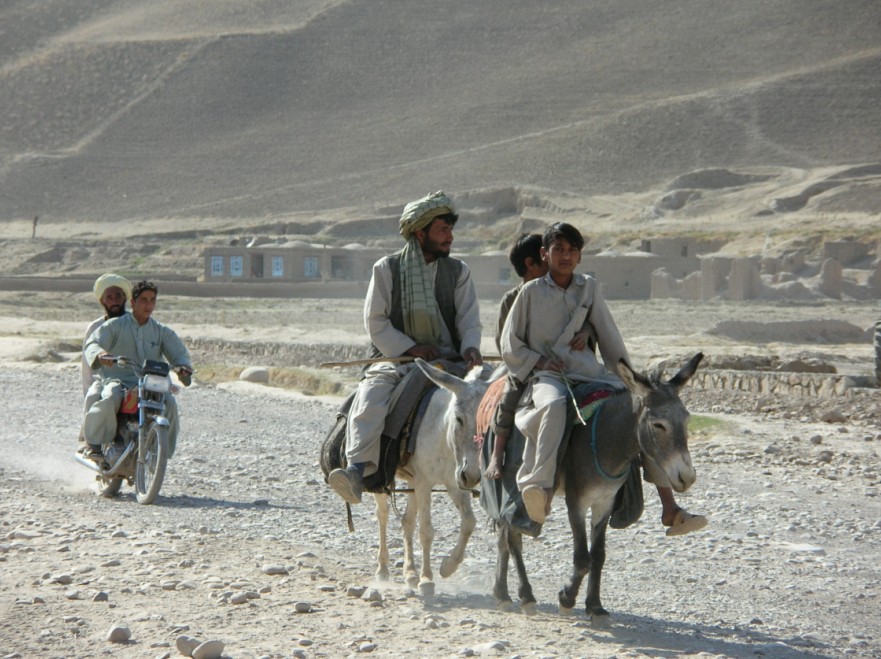



European Parliament Resolution of 20 April 2023 on the crackdown on the right to education and education rights activists in Afghanistan, including the case of Matiullah Wesa (2023/2648(RSP)) – EN


European Parliament Resolution of 30 March 2023 on the proposal for a decision of the European Parliament and of the Council on a European Year of Skills 2023 (COM(2022)0526 – C9-0344/2022 – 2022/0326(COD)) – EN


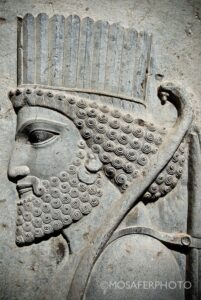
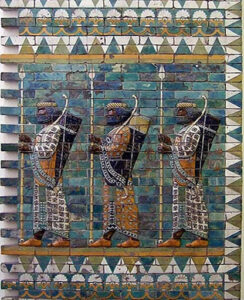

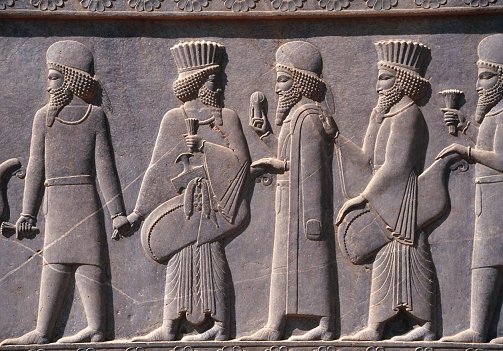
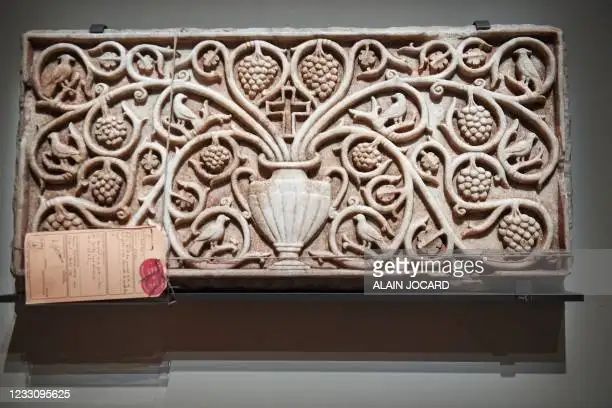
Today, the European Commission has presented an Action Plan to fight illicit trafficking of cultural goods. With a multidisciplinary and comprehensive approach, the Communication includes measures to prevent, detect, investigate and prosecute criminal activities against cultural goods, and ways to strengthen and improve police and judicial cooperation in this field – EN
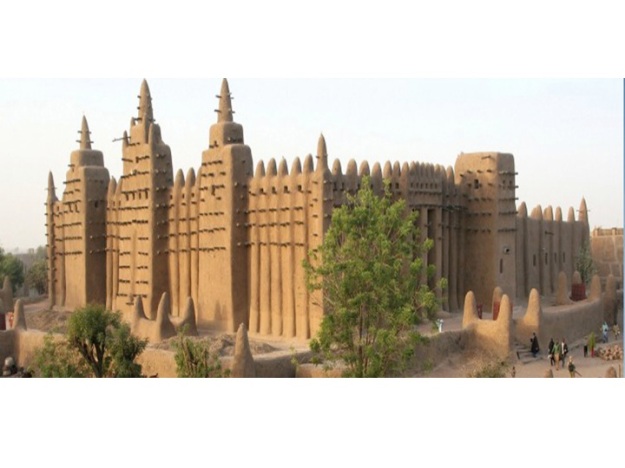
Tombuctú es una legendaria ciudad, siempre acompañada de historia y misterio, situada en el centro de Mali y muy cerca del río Níger. Es considerada una de las perlas del desierto del Sáhara y la ciudad de los 333 santos.
Parece, sin ser seguro, que la ciudad se fundó por las tribus de los tuareg hacia el año 1.100 d.C. Muy pronto se convirtió en un enclave principal de la zona del Sahel, y un punto de encuentro entre las caravanas de comerciantes tuareg que traían la sal desde el Mediterráneo y la intercambiaban por oro, fruta y pescado procedentes de las rutas del este y del sur. Tombuctú se convirtió así en una ciudad próspera.
Su época dorada llegó un tiempo después, cuando el rey del Imperio de Mali Mansa Musa se anexionó la ciudad y favoreció la construcción de algunos de sus edificios más representativos. Mansa Musa (1280-1337?) era un devoto musulmán conocido por su peregrinación a La Meca desde la ciudad de Tombuctú. Se cuenta que movilizó más de 12.000 esclavos y que parte de su caravana la formaron 80 camellos que transportaban cada uno entre 30 y 120 kilos de oro. También se llevó Mansa Musa consigo a los hombres más poderosos de la ciudad, para evitar que durante su ausencia tuvieran ocasión de conspirar contra él.
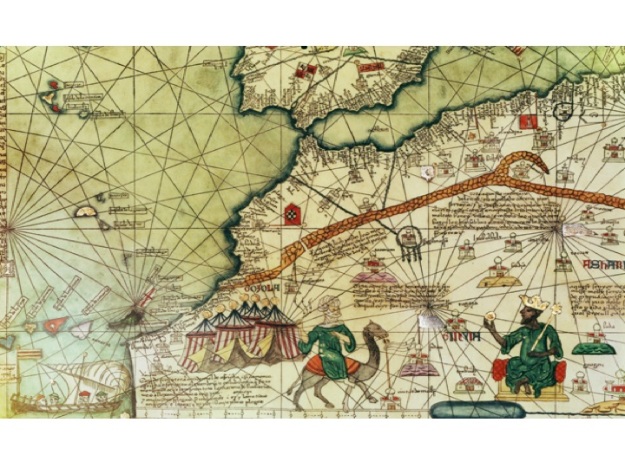
Detalle de una página del Mapamundi de Abraham Cresques, de Mallorca. Mansa Musa aparece representado con corona y cetro al estilo europeo, y sostiene en una de sus manos una enorme pepita de oro.
A su vuelta a Tombuctú encargó al arquitecto granadino Abu Haq Es Saheli la edificación de la Mezquita de Djingaeyber. Es Saheli había llegado hasta Tombuctú huyendo de una revuelta en el sur de Al-Andalus. El monarca le dio protección y trabajo. Es Saheli le correspondió con uno de los edificios más bellos de la ciudad.
La Mezquita de Sankore, después convertida en Universidad, fue también mandada construir por Mansa Musa. A ella comenzaron a llegar matemáticos, astrónomos y juristas musulmanes de otros lugares de África y Oriente Medio.
Tombuctú alcanzó su máximo esplendor durante los siglos XV y XVI, coincidiendo con la dinastía de los Askia y, tiempo después, con la anexión de la ciudad al Imperio Songhay. Durante el reinado de los Askia vivían en la ciudad más de 100.000 habitantes de distinta raza y procedencia.
Por aquel entonces la ciudad tenía ya su conocida muralla y albergaba en el interior dos de las tres mezquitas y los edificios de adobe tan característicos de su arquitectura. Numerosas madrazas se instalaron también en la ciudad de Tombuctú. La ciudad comenzó a poblarse de pequeños santuarios dedicados a hombres santos que habían vivido en ella y protegían a sus habitantes contra el infortunio.
La ciudad seguía siendo un importante foco comercial.
Además, se había convertido en un referente cultural para Oriente y Occidente y una capital intelectual y espiritual a la altura de ciudades como Córdoba y Damasco. La citada Mezquita de Sankore es considerada como una de las primeras Universidades del mundo. A ella continuaron llegando estudiantes, letrados y científicos españoles, beréberes, mauritanos, árabes y persas.
A la ciudad de Tombuctú llegó también el morisco Ali Ben Ziyad al-Quti tras huir de la ciudad de Toledo en 1467. Se había llevado consigo su importante colección de manuscritos islámicos y medievales escritos en hebreo, castellano antiguo y árabe. Así comenzó la historia del Fondo Kati.
En cuanto a la dinastía Songhay, a un primer monarca con creencias animistas le siguió un nuevo devoto musulmán que favoreció el estudio de la religión islámica.
Hacia 1590, la ciudad fue invadida por los sultanes de Marruecos ayudados por nuevos moriscos que habían sido expulsados de Toledo y otras ciudades castellanas. El acceso a la ciudad se mantuvo prohibido para los no creyentes en el Islam, lo cual tuvo como justa correspondencia el extraordinario interés de los exploradores europeos de finales del siglo XVIII y del XIX para llegar hasta ella y sobre todo volver para contarlo.
Poco a poco la ciudad fue perdiendo el favor de los sultanes de Marruecos y su importancia decayó.
En 1893 la ciudad pasó a formar parte del Imperio Colonial Francés, tras haber opuesto las tribus tuaregs mucha resistencia.

Manifestación de un grupo de tuaregs ante la Oficina Colonial. Cartas Históricas, PRIEZ y RENAUT (1999),
En 1960 el Sudán francés obtuvo la independencia y comenzó a llamarse Mali. La capital se instaló en Bamako, en la mitad sur del país. Desde entonces las tribus tuaregs han reivindicado una mayor autonomía de la capital, o su total independencia, en al menos cuatro revueltas.
La última de las revueltas tuaregs se originó en enero de 2012. Por una serie de acontecimientos que se sucedieron en cadena tuvo como consecuencia la destrucción de una de las mezquitas de la ciudad, numerosos templos sagrados y antiguos manuscritos que se guardaban en colecciones privadas en el interior de sus murallas.
A principios de 2012 Tombuctú contaba con tres mezquitas y con al menos 16 templos dedicados a santos protectores de la ciudad.
La Mezquita de Djingareyber
La Mezquita de Djingareyber está situada en el extremo oeste de la ciudad antigua. Como se ha señalado, fue construida por el arquitecto andalusí Abu Eshaq Es-Saheli al-Touwaidkin, por encargo del sultán de Mali Abu Musa a la vuelta de su peregrinación de La Meca en 1325. En una reconstrucción posterior, ya en tiempos del cadí de Tombuctú Elhadj Al-Aqib, se añadió su parte sur. La mayoría de la Mezquita está construida en adobe. Presenta tres naves interiores y dos minaretes.
La Mezquita de Sankoré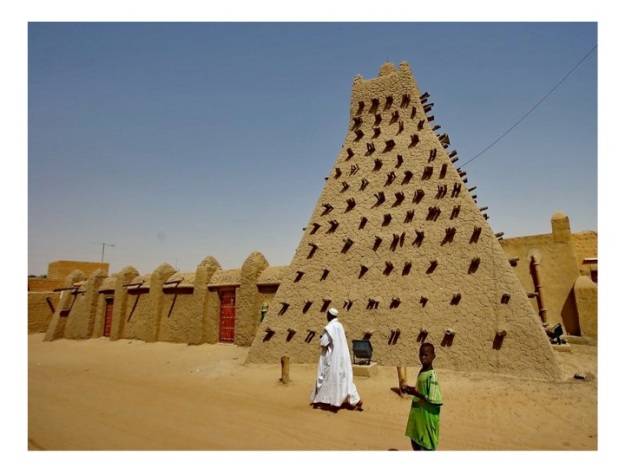
La Mezquita de Sankoré está construida en la zona noreste de la ciudad, en el barrio que lleva su mismo nombre. También mandada construir por Mansa Musa, entre 1578 y 1582 el Imán El Hadj Al Aqib la reconstruyó y otorgó las dimensiones de la Kaaba, que había conocido durante su peregrinaje a los lugares santos en 1581. Construida totalmente en adobe, su estructura y estilo es similar a la Mezquita de Djingareyber. Cuenta con tres naves y un minarete de unos 15 metros de altura. La parte norte alberga las aulas de la Universidad de Sankore
La Mezquita de Sidi Yaya
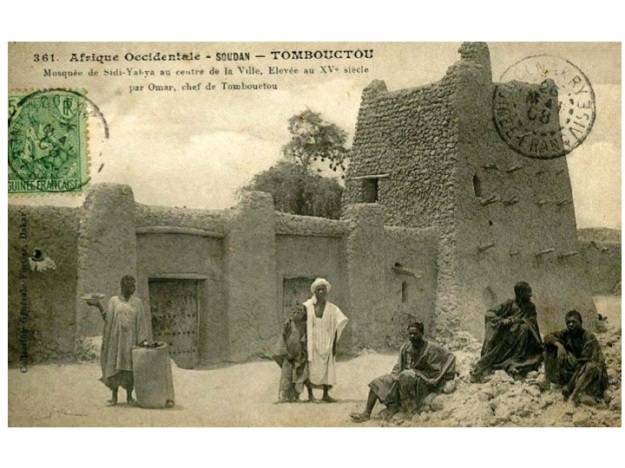
«Fortier 361 Timbuktu Sidi-Yabya Mosque» de Edmond Fortier (1862-1928) – Downloaded from http://www.dogon-lobi.ch/historical2.htm. Disponible bajo la licencia Dominio público vía Wikimedia Commons
La Mezquita de Sidi Yaya está situada en el centro de la ciudad antigua. Fue construida hacia el año 1400 por el gobernador Cheick El Mokhtar Hamallah, pero toma su nombre de un gobernador posterior, Sidi Yahia El Tadlissi, que reclamó las llaves de la mezquita unos años después. El santuario se restauró en 1577-78 y sufrió importantes transformaciones en 1939, entre ellas, el antiguo minarete se transformó en una torre y los arcos originales se sustituyeron por unos ogivales. La Mezquita comprende tres naves interiores para los rezos de invierno y un patio exterior para los rezos de verano.
Por otro lado, los edificios destinados al culto de sus santones pueden parecernos no tan espectaculares como nuestras catedrales e iglesias románicas o góticas, pero para los habitantes de la ciudad tienen el mismo valor cultural y espiritual. En enero de 2012 existían 16 templos en Tombuctú. Los santos a los que estaban dedicados eran considerados los protectores de la ciudad y habían contribuido en tiempos remotos al progreso espiritual y filosófico de sus gentes. Sus nombres son los siguientes:
Nos ocupamos con un poco más de detalle del primero de ellos, siguiendo el informe del arquitecto urbanista Pietro M. Apollonj Ghett (vid infra, bibliografía).
Cheikh Sidi Mahmoud Ben Omar Mohamed Aquit (1494-1548) es un santo de gran reputación. Nació en Tombuctú en el año 868 de la Héjira y falleció en la misma ciudad el año 955 de la Héjira. Fue el primer santo venerado en la ciudad y se encuentra enterrado a unos 150 metros al norte de la ciudad, en su antigua casa, siguiendo la tradición oral. Junto a él están enterrados otros 167 santos. Era un gran erudito, profesor y jurista revestido de autoridad y dignidad. Fue además autor de numerosas obras. Padre de cuatro hijos, se dice que cuando falleció uno de ellos permaneció totalmente en silencio mientras recibía las condolencias. Unos días después se disculpó y explicó que había sido debido a que en aquel momento estaba siguiendo la lucha del alma de su hijo con los ángeles. El cementerio que rodea su santuario es el lugar de enterramiento de sus descendientes y de todos aquellos que le rinden culto a diario.
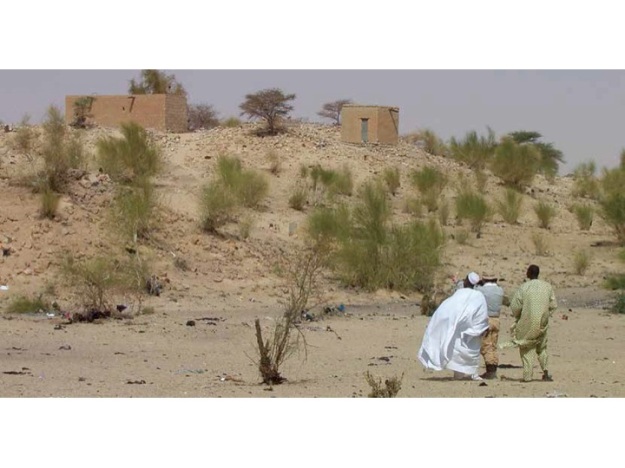
Cementerio de Sidi Mahmoud Ben Omar, con el Mausoleo de Cheikh Sidi Mahmoud Ben Omar Mohamed Aquit a la izquierda, y el Mausoleo de Cheikh Mohamed Mahmoud Al Arawani a la derecha, así como otras tumbas. c Pietro M. Apolloni Ghetti
Esta es la planta del templo:
Aquí puede verse su alzado desde las distintas fachadas:
A raíz del conflicto, dos de las mezquitas y los 16 templos sagrados fueron destruidos por las milicias de Ansar Dine.
Así quedó el templo dedicado a Sidi Mahmoud Ben Omar Mohamed Aquit:
Tombuctú es igualmente conocida por las colecciones de manuscritos que han permanecido durante siglos en el interior de sus murallas. La mayoría de ellos llegaron a la ciudad en la época de su mayor esplendor y procedían de la península ibérica o del Lejano Oriente.
Ya nos hemos referido al Fondo Kati, que comenzó a gestarse a partir de un conjunto de documentos originales que salieron de la ciudad de Toledo junto al resto de pertenencias de Ali Ben Ziyad al-Quti cuando tuvo que salir huyendo de la ciudad.
Los estudiantes, pensadores, filósofos y escritores que se desplazaban hasta Tombuctú para aumentar su saber llevaron también consigo documentos originales que acrecentaron el patrimonio documental de la ciudad.
El conflicto de Mali surgido en enero de 2012 amenazó gravemente los valiosos manuscritos de Tombuctú. Muchos de ellos consiguieron salir de manera clandestina hacia otros países como España o hacia la capital. Así sucedió con el Fondo Kati.
Otros documentos no tuvieron la misma suerte. En Junio de 2013, tras una visita de evaluación, UNESCO estimaba que alrededor de unos 4.200 manuscritos del centro de investigaciones Ahmed Baba habían sido destruidos, y que otros 300.000 eran vulnerables al tráfico ilícito de bienes culturales.
La Tumba de la Dinastía Askia en Gao
La Tumba de los Askia es en realidad un complejo que alberga varios edificios, incluida una pirámide funeraria de 17 metros de altura, dos edificios de techo plano que constituyen su mezquita, un cementerio y un ágora al aire libre. La pirámide funeraria fue construida por la Dinastía de los Askia en 1495 cuando Gao se convirtió en la capital del Imperio Songhai.
Las Ciudades Antiguas de Djenné
Djenné, cuyos primeros asentamientos se remontan al 250 a.C., fue un centro comercial importante y un eslabón de la ruta subsahariana del oro y la sal. A partir del siglo XV constituyó igualmente un centro relevante de propagación del Islam. Sus viviendas tradicionales, hechas de adobe y fieles a la arquitectura subsahariana occidental, se construyeron en pequeñas colinas para protegerlas de las inundaciones estacionales.
UNESCO siguió muy de cerca el conflicto que asolaba Mali desde principios de 2012, temerosa de que los enfrentamientos dañaran gravemente el valioso patrimonio cultural de Tombuctú y otras ciudades del norte, como efectivamente sucedió.
Tras varias visitas de evaluación, a principios de 2013 UNESCO comenzó a ayudar a las autoridades locales a elaborar inventarios sobre sus bienes patrimoniales, incluidos los dañados o difícilmente recuperables.
También centró sus esfuerzos en la implementación de un Plan de Acción que permitiera recuperar el patrimonio cultural dañado en Tombuctú, proteger sus antiguos manuscritos, y reforzarlas capacidades de conservación y gestión del patrimonio cultural de Tombuctú por las autoridades locales. El Plan de Acción se sitúa en la misma línea que otras iniciativas pasadas, como las que permitieron proteger los templos de Egipto durante la primavera árabe o reconstruir el puente de Mostar sobre el río Neretva. Con ellas se pretende devolver a las poblaciones locales elementos esenciales de su memoria y su indemnidad colectiva, así como contribuir a la reconstrucción de la paz y la reconciliación.
Como resultado de este Plan de Acción, en el verano de 2015 UNESCO anunció haber terminado con éxito la reconstrucción de las mezquitas y los templos demolidos por Ansar Dine.
La Corte Penal Internacional permaneció también atenta al desarrollo de los acontecimientos en Mali. Poco después de surgir el conflicto, advirtió a las partes contendientes que los delitos cometidos en el norte del país, incluido la destrucción de sus templos sagrados, podrían ser investigados y perseguidos por la Corte como crímenes de guerra.
En enero de 2013, la Oficina del Fiscal de la Corte Penal Internacional emitió un informe en el que concluía que concurrían indicios suficientes para abrir una investigación al amparo del Art. 53(1) del Estatuto de la Corte.
En Septiembre de 2015, a petición de la Fiscalía, la Sala de Cuestiones Preliminares emitió una orden de arresto internacional contra Ahmati Al Faqi Al Mahdi por la destrucción de los templos sagrados de Tombuctú.
Más información:
Bibliografía y documentos relevantes:
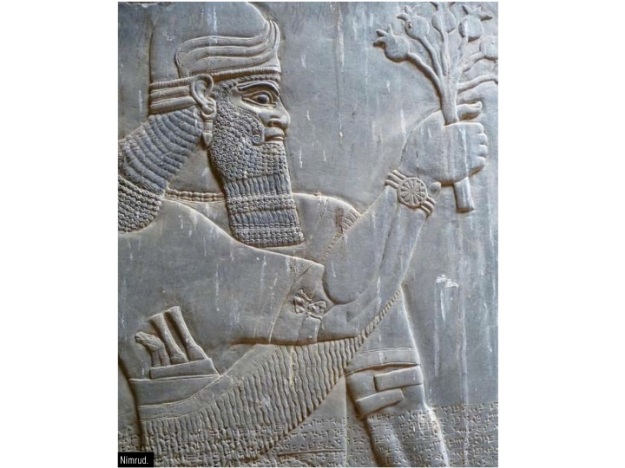 Iran, Iraq, Lybia, Syria and other countries of Middle East have an exceptional archaeological heritage, including world-famous sites and treasures of ancient civilizations as the Sumerians, Akkadians, Babylonians, Assyrians, Hittites, or the Persian Empire.
Iran, Iraq, Lybia, Syria and other countries of Middle East have an exceptional archaeological heritage, including world-famous sites and treasures of ancient civilizations as the Sumerians, Akkadians, Babylonians, Assyrians, Hittites, or the Persian Empire.
In recent years these sites are under threat, many of them being destructed or seriously damaged as result of civil wars and armed conflicts. The irruption of the Islamic State in Iraq and the Levant (ISIL), AL Nushah Front (ANF) and other individuals, groups, undertakings and entities associated with Al-Qaïda have aggravated the situation enormously. They have intentionally destructed cultural and religious buildings in sites as famous as Nínive and Palmyra. They have also seriously damaged, looted and smuggled cultural heritage items from libraries, archives and museums, as the Mosul Museum, many of them being now the victims of illegal trafficking
Iraq
Among the archaeological sites of Iraq (some of them included in UNESCO World Heritage List), terrorist attacks have seriously affected Hatra, Samarra, Nimrud and the Ancient City of Nineveh.
Hatra started as a small Assyrian settlement, which went on to become a fortress and a commercial centre of the famous oriental Silk Road. It was also the capital of possible the first Arab Kingdom in the chain of Arab cities. In April 2015, unvaluable elements of this 2.000 years-old civilization were deliberately destroyed by Daesh.
Samarra is located 130 kms north of Bagdad and considered one of the largest archaeological sites in the world. It was build in AD 836 by Caliph al -Mutasim, and developed by seven successive rulers until 892, when Baghdad was reinstated as the capital.
Nimrud was founded by the Assyrian King Shalmaneser I (1274-1245 BC) and became soon of the main cities of the Assyrian Empire. With the King Ashurnashirpal II (883-859 BC), Nimrud became the capital of the Empire (at the expenses of Assur) and a cosmopolitan flourishing city which remained the capital of the Empire during 150 years. In February and March 2015, Daesh continued its cultural cleansing by targeting cultural icons and historic monuments in Nimrud.
The Ancient City of Nineveh was settled as early as 6000 BC and became the capital of the Neo-Assyrian Empire round 700 BC, during the Senacherib reign (705-681 BC). It is considered one of the most prominent cultural centres of antiquity that significantly contributed to the development of human civilization. The limits of the ancient location are marked with two principle mounds (tells) named Kouyunjik and Nabi Yunus (the so called «Nergal Door»), and the city wall with 12 kms in circumference.
Nineveh was also attacked by Daesh in February 2015 and the Nergal Door seriously damaged intentionally with power drills.
In Mosul, the Mosque of Yunus Prophet was dynamited in July 2014:
Very valuable pieces exhibited in Mosul Museum were also seriously damaged by Daesh members beginning of 2015. Whether Daesh destroyed the original pieces, or only copies whose originals are subject to illegal trafficking, is still unknown.
The Syrian civil war, combined in the recent past with Daesh terrorist activities in the region have devastated partly the amazing cultural heritage of Syria.
The oasis of Palmyra, commonly known as «the Pearl of the Desert» is being particularly targeted by Daesh.
The Baal Shamin Temple was destroyed in July-August 2015
The Arch of Triumph, considered one of the most exquisite sites included in the World Heritage List of UNESCO, was reported to have been destroyed in October 2015.
The image below corresponds to Mr Khaled al-Asaad, the Syrian archaeologist who was the head of antiquities for the ancient city of Palmyra. He helped evacuating the city Museum when he was captured by Daesh and retained for several weeks, forced to reveal the location where the cultural goods were hidden to protect them from extremists. He was finally murdered in a public place in August 2015. This is our little tribute to him… 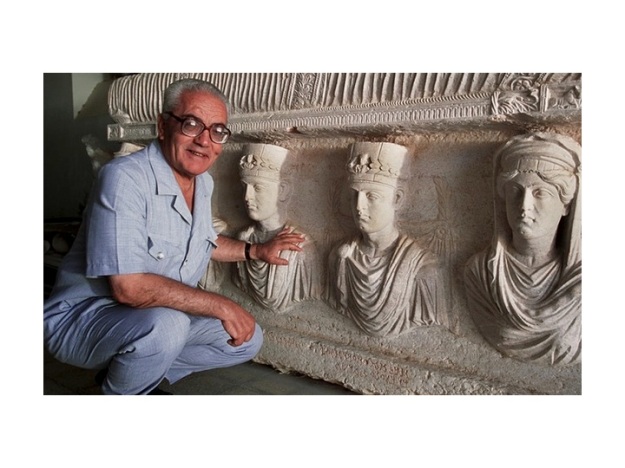 Information re Iraq is mostly extracted from:
Information re Iraq is mostly extracted from:
During the confirmation of charges hearing of 1st March 2016, Mr Al Mahdi had expressed his intention to plead guilty of war crimes of attacking historic and religious buildings of Timbuktu.
The trial of ICC Case The Prosecutor v. Ahmad Al Faqi Al Mahdi (ICC-01/12-01/15) took place on 22-24 August 2016.
As announced, at the opening of this trial Al Mahdi admitted his guilt. Subsequently, the Prosecution presented evidence and called three witnesses. The Legal representative and the Defence presented their remarks before the Trial Chamber on 24 August.
The ICC Trial Chamber VIII was composed of Judge Raul Cano Pangalagan as Presiding Judge, Judge Antoine Kesia-Mbe Mindua and Judge Bertram Schmitt.
On 27 September 2016, this Trial Chamber unanimously found Mr Al Mahdi guilty beyond reasonable doubt as a co-perpetrator of the war crime consisting of internationally directing attacks against religious and historic buildings of Timbuktu, in Mali, including nine mausoleums and one mosque, in June and July 2012. Mr Al Mahdi was sentenced to nine year´s imprisonment and the time already spent by the suspect in detention will be deducted from the sentence.
The Spanish General Prosecutor´s Office has recently issued its Annual Report 2017, containing most relevant features of the work carried out by the Spanish Prosecutors in 2016.
Full text of the Annual Report is available here.
Chapter III Section (3) of this Annual Report describes the activities performed in 2016 by the Specialised Unit on Environment, Urban Planning and Cultural Heritage. Relevant facts and figures on this Specialised Unit, in the particular area of Cultural Heritage, are as follows:
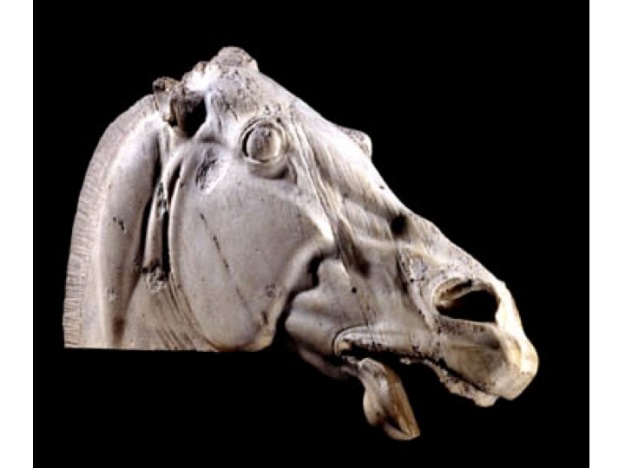
On 12 of July 2014, a small group of members of UK Parliament presented the Early Day Motion n. 317. This motion calls on the Government, working with the Trustees of the British Museum, to engage in a gracious act to reunite the Parthenon sculptures exhibited at the British Museum with those located in Athens and with the people of Greece. The motion was presented with the occasion of the 200th anniversary of the purchase of such sculptures from Lord Elgin by the British Museum.
The Early Day Motion 317 is available here
In the framework of the 2015 European Agenda on Security and in line with recent Declarations of the High Representative of the EU for Foreign Affairs, the European Parliament and the Council, EU Commissioner Moscovici has presented in July 2017 a new Proposal for a EU Regulation on the import of cultural goods.
As mentioned in its Explanatory Memorandum, this EU Proposal
«Aims to prevent the import and storage in the EU of cultural goods illicitly exported from a third country, thereby reducing trafficking in cultural goods, combatting terrorism financing and protecting cultural heritage, especially archaeological objects in source countries affected by armed conflict. For this purpose it proposes to: establish a common definition for cultural goods at import; ensure importers exercise diligence when buying cultural goods from third countries; determine standardized information to certify the goods are legal; provide for effective deterrents to trafficking; and promote the active involvement of stakeholders in protecting cultural heritage».
The Proposal for a EU Regulation on the import of cultural goods is available here.
Radicalisation ha become a major concern at both International and European level, and also in Spain. The terrorist attacks perpetrated in the past few years and those committed last days in Manchester and London were committed mostly by European citizens, who were born and grew in EU Member States, and radicalized and attacked fellow citizens.
The prevention and fight against radicalization and violent extremism leading to terrorism required a multidisciplinary approach, covering not only investigative measures and criminal proceedings against these types of crime, but also social cultural, ideological, and religious factors accelerating radicalization processes of men and women leading them to travel to conflict areas (Syria, Irak) in order to combat in Daesh or serve its intereses and returning to their countries of origin with an extremist ideology.
In line with policy measures adopted by International and European institutions, the Summer Course analyses this phenomenon with a multidisciplinary approach: legal, humanist, educative, protective of our cultural heritage, committed with third countries and areas of conflict. Only this approach makes possible countering terrorist propaganda and hate speech in Internet, as well as combating the return of foreign fighters, among other risks, whilst promoting inclusive societies, educational policies on values and, most important, an attitude of tolerance towards other cultures and religious.

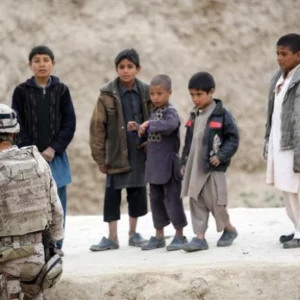
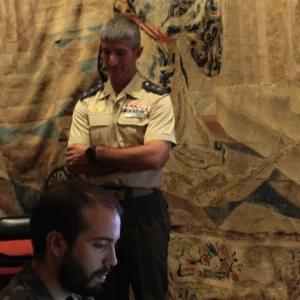
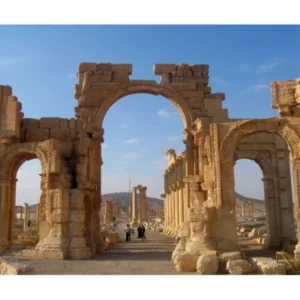
Target group
University professors, researchers, students and public in general
Director
Prof. Dr. Ángeles Gutiérrez Zarza
Secretariat
Mr. Santos Jaime Valor and Ms Laura Gutiérrez Martín
Registration
Unique fee: 50 Sur
Deadline: 30 June 2017
More information and registration at proyecto.cultureaw@uclm.es
Agenda in EN is available here
Agenda in ES is available here
On 26 May 2017, the Leaders of G7 meeting at Taormina issued a Statement on the Fight Against Terrorism and Violent Extremism.
In this Statement, the Leaders condemned terrorist attack of Manchester and terrorism in all its forms and manifestations, and proclaimed that the fight against terrorism and violent extremism remains a major priority for the G7.
Further to the G7 Action Plan adopted in Ise-Shima, the Leaders of G7 tasked their Ministers of Interior to meet as soon as possible to focus on the implementation of a set of measures in close cooperation with private sector and civil society, including (1) the misuse of Internet by terrorists, (2) the risk posed by foreign fighters as they disperse from theaters of conflict, (3) existing sources and channels of terrorist financing and the financing of violent extremists, (4) the flow and return of foreign fighters using regular flights (5) the diversion of weapons into the hands of terrorists, (6) information sharing functions of Interpol.
As regards culture and the protection of cultural heritage, the G7 Statements is as follows:
“11. We are convinced of the distinctive role of culture as an instrument to fight terrorism. Cultivating culture is a way to foster tolerance and dialogue among peoples, mutual understanding, religious pluralism, and recognition and respect for diversity. Culture contributes to the preservation of identity and the memory of mankind, encourages dialogue and exchanges among nations, and, ultimately, can be an extraordinary instrument to prevent radicalization and violent extremism, especially among youth.
12. We also affirm our strong determination to cooperate in protecting cultural heritage and countering the looting and trafficking of cultural property. Such property is a source of financing for activities of terrorist groups and organizations, but also a heinous means to eradicate cultural diversity from the territories under their control”.
See G7 Taormina Statement on the Fight Against Terrorism and Violent Extremism.
The Council of Europe Convention on Offences relating to Cultural Property has been adopted the 3rd of May 2017.
The Treaty will be opened for signature in Nicosia (Cyprus) on 19 May, during the 127th Session of the Council of Europe’s Committee of Ministers, which will bring together the Ministers for Foreign Affairs from the organisation’s 47 Member States.
The ancient city of Hatra, at the Departament of Nineveh in Iraq, has been liberated in the past few days from Daesh. Unesco has confirmed the news and announced the intention to send an archeological mission to the city as soon as the security in the area is ensured. .
On the damages perpetrated by Daesh in this city, and in many other archeological places of the region, Ms Irina Bokova mentioned:
“Violent extremists know the power of heritage to unite, to bring people together and provide them with pride, confidence and dignity – this is why they target and destroy heritage. The protection of heritage has become more than a cultural issue – it is also a security issue, and this is the spirit of the recent Resolution 2347 adopted unanimously by the UN Security Council on 24 March, putting culture at the heart of international efforts to build peace (…). The deliberate destruction of heritage is a war crime, and UNESCO will do everything in its power to ensure these crimes do not go unpunished. I call on all parties to preserve this unique heritage as an essential condition for peace and the future of the region”.
Ley 1/2017, de 18 de abril, sobre restitución de bienes culturales que hayan salido de forma ilegal del territorio español o de otro Estado miembro de la Unión Europea, por la que se incorpora al ordenamiento español la Directiva 2014/60/UE, del Parlamento Europeo y del Consejo de 15 de mayo de 2014 – ES
TRANSL.: Law 1/2017 of 18 April on return of cultural objects unlawfully removed from the territory of Spain or other EU Member State, implementing Directive 2014/60/EU, on the European Parliament and the Council of 15 May 2014 (only available in Spanish).
 Security Council Resolution S/RES/2347 (2017) on Maintenance of International Peace and Security – EN
Security Council Resolution S/RES/2347 (2017) on Maintenance of International Peace and Security – EN